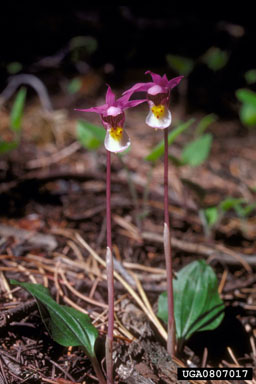Last updated: November 17, 2022
Article
Calypso Orchid

Dave Powell, USDA Forest Service (retired), Bugwood.org, CC BY 3.0 US
General Description:
The calypso orchid (Calypso bulbosa (L.) Oakes) is a perennial in the orchid family (Orchidaceae) and is the only member of the Calypso genus. The Sierra Nevada range separates the two US varieties, with C. bulbosa var. americana to the east and var. occidentalis to the west. Other names for the orchid are fairy slipper, Venus’ slipper, and angel slipper. The orchid has one green, basal, elliptic to ovate leaf, 1-3 in (2.5 – 7.6 cm) long. The solitary flower occurs at the top of a 4 in (10 cm) tall reddish stalk. The lower petal forms a long, scoop-shaped pink to white lip with red-purple spots and two horns. The anther column is pink-purple and flat, covering the lip opening. The upper sepals and petals are a similar pink-purple color and lanceolate (narrow and pointed at the tip). Flowers bloom from March through July.
Reproduction:
The calypso orchid relies on deception for pollination, in that it does not provide nectar to the pollinator (mainly bumble bees). Individual pollinators eventually learn not to revisit the species for nourishment. Following flowering, the orchid will asexually give rise to a new shoot from the nodal region of its corm (a vertical underground stem with thin papery leaves), which will become a new corm.
Interesting Facts:
Native Americans used the corms as a food source and the Thompson Indians (British Columbia) used it to treat epilepsy. The orchid is named for the beautiful and secretive sea nymph in Homer’s Odyssey. Calypso also means “concealed” in Greek, a reference to the flower’s preference for sheltered areas on conifer forest floors.
Where to see it in the Klamath Parks:
NPSpecies documents evidence of the calypso orchid in Crater Lake National Park, Oregon Caves National Monument, Redwood National and State Parks, and Whiskeytown National Recreation Area.

Daniel Sarr, NPS
Habitat:
Calypso orchids inhabit moist forests with cool, rich soils and decaying leaves and wood. The plant occurs in shady areas from sea level to mid-montane elevations and in forests of all stages of succession. In the Pacific Northwest, it is most commonly found in mature to old-growth Douglas-fir forest.
Distribution:
The calypso orchid has a circumpolar distribution occurring across Europe, Asia, and North America. In North America, it occurs across Canada and the US, from Alaska to Newfoundland, and south into California, Michigan, New Mexico, and Vermont. Some historic populations in New York and New Hampshire are now extirpated.
Status:
The orchid is not federally listed as threatened or endangered. However, it is state listed as threatened in Michigan, Vermont, and Wisconsin, and endangered in New York and New Hampshire. This is in part due to its sensitivity to disturbance and dependence on specific soil fungi.
Additional Information:
For more information, visit: the US Forest Service Fire Effects Information System and the University of Washington Burke Museum web sites.
Prepared by Tim Shepherd
NPS Klamath Inventory & Monitoring Network
Southern Oregon University
1250 Siskiyou Blvd
Ashland, OR 97520
Featured Creature Edition: July 2007
